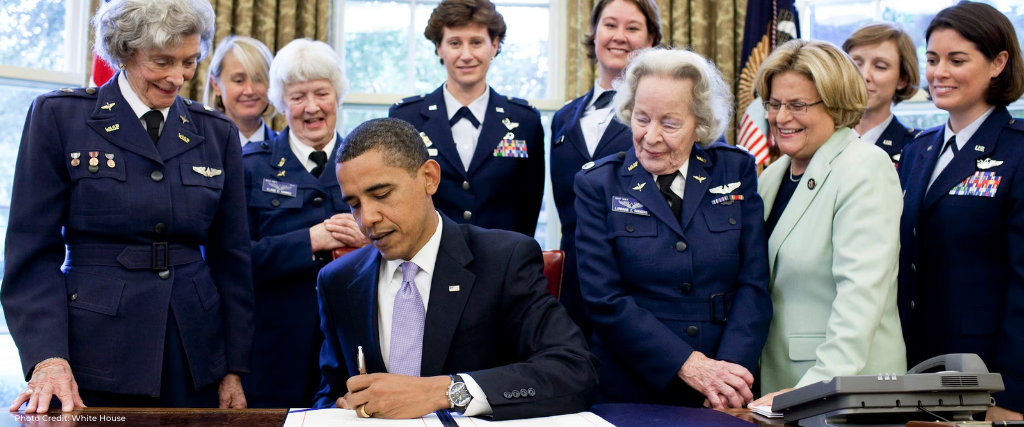Women’s History Month makes me think about the incredible women aviators that have come before me. I’ve always been encouraged by the legacies of iconic women aviatrixes like Bessie Coleman, Amelia Earhart and Poncho Barnes. As a kid I never learned about women military aviators, until I discovered my SHEroes, the Women Airforce Service Pilots (WASP) of WWII. These brave women were the first ever to fly for the U.S. military, and they inspired me to push forward with my dream of becoming a fighter pilot.
By 6th grade, I knew I was going to be a military fighter pilot. I loved Air Force and Navy fighter jets. I didn’t dwell on the fact that I hadn’t learned about any women military aviators until it was my turn to give a presentation on what I wanted to be when I grew up. Each Friday, a kid or two would stand up and be vulnerable with their dreams in front of their classmates. The day I was selected to speak, I stood up and announced I would be a fighter pilot someday.
Immediately, some in the class started laughing and scoffing at the idea. I froze, speechless. My teacher at the time stated, “Women can’t be fighter pilots. Maybe you should come back next week with something else.” I was devastated and started to get teary eyed. I felt embarrassed. I know the teacher wasn’t trying to be mean, as he was factually correct. But, at that time, I didn’t know that women couldn’t be fighter pilots. It was literally against the law. Who knew?
Historically speaking, women had only been in military pilot training for a few years by then and were not allowed to be fighter pilots. Learning that fact was a devastating discovery for this 12-year-old. I remember thinking my dream would never happen. Luckily, my family took a vacation to Washington, D.C., in the summer of 1986.
On our trip I begged to visit the Smithsonian National Air and Space Museum. As I walked through the displays, I began to ponder the idea that if I couldn’t fly in the military, maybe I could become a commercial airline pilot. So, I found myself drawn to the limited (at that time) displays on women airline pilots. Then, I saw a tiny, dimly lit, dusty photo. A collage of women in uniform standing in front of a B-17. There they were… the WASP.
It was as if the skies had parted and heaven itself was shining down on me. Then I read the accompanying exhibit content and learned women had flown military aircraft in WWII. I knew then that my dream of being a military aviator was possible. The dream was reignited, and the WASP have remained a catalyst for me ever since.
A lasting legacy
The WASP were the first women in history to fly American military aircraft. During the early months of WWII, there was a severe shortage of combat pilots. Jacqueline Cochran, America’s leading woman pilot of the time, convinced General Hap Arnold, Chief of the Army Air Forces, that women, if given the same training as men, would be equally capable of flying military aircraft and could then take over some of the stateside military flying jobs, thereby releasing hundreds of male pilots for combat duty. More than 25,000 American women applied for training, but only 1,830 were accepted and took the oath; exactly 1,074 of those trainees successfully completed the flight training, earning their WASP wings. They flew more than 60,000,000 miles for their country in every type of aircraft and on every type of assignment flown by the male Army Air Forces pilots, except combat. 38 women lost their lives while serving their country. With victory in WWII almost certain, on December 20, 1944, the WASP were quietly and unceremoniously disbanded; there were no honors, no benefits, and very few “thank you’s”. Their legacy was, therefore, never codified in our history books. It wasn’t until 33 years after their service that veteran status was granted to the WASP. And they would be denied burial at Arlington National Cemetery until that law was changed in 2015.
Despite so many challenges, they only speak positively of their service and ability to defend our nation. I had the tremendous honor of speaking with some of these WASP over the years, as a grateful military aviator who had the great fortune to follow in their footsteps. During our conversations something struck me. They were all so humble. They had a passion for our country and their sole motivation was protecting the free world during the darkest days of WWII. They did it not for glory. Not for fame. Not for recognition. They did it out of pure patriotism and skill.
The WASP are true American heroes. A very small team of determined individuals supported me as I drafted a bill (Public Law 111-40) to award the Congressional Gold Medal to these pioneering aviators. This tiny team of ours managed to get the ball across the goal line, a wonderful story for another day. The bill was championed by then Senator Kay Bailey Hutchinson of Texas. The bill became law in 2009, and the WASP were awarded the Congressional Gold Medal in March of 2010. The WASP laid the groundwork for generations of women military aviators, including me. Without them, I would never have had the opportunity and privilege to serve my country as a pilot. They have my never-ending gratitude and admiration.
To learn more about the WASP, and watch them receive their Congressional Gold Medal during the Washington, DC, ceremony in 2010, please click here: https://www.c-span.org/video/?292460-1/women-airforce-service-pilots-gold-medal-ceremony

